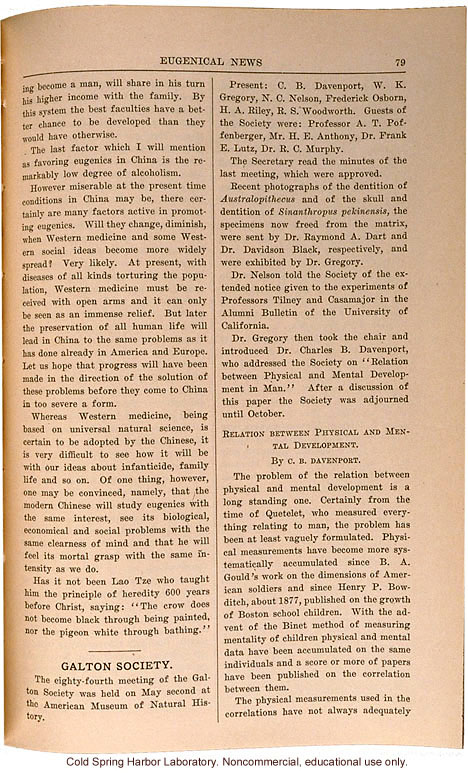Eugenical News 79
ing become a man, will share in his turn his higher income with the family. By this system the best faculties have a better chance to be developed than they would have otherwise.
The last factor which I will mention as favoring eugenics in China is the remarkably low degree of alcoholism.
However miserable at the present time conditions in China may be, there certainly are factors active in promoting eugenics. Will they change, diminish, when Western medicine and some Western social ideas become more widely spread? Very likely. At present, with diseases of all kinds torturing the population, Western medicine must be received with open arms and it can only be seen as an immense relief. But later the preservation of all human life will lead in China to the same problems as it has done already in America and Europe. Let us hope that progress will have been made in the direction of the solution of these problems before they come to China in too severe a form.
Whereas Western medicine, being based on universal natural science, is certain to be adopted by the Chinese, it is very difficult to see how it will be with our ideas about infanticide, family life and so on. Of one thing, however, one may be convinced, namely, that the modern Chinese will study eugenics with the same interest, see its biological economical and social problems with the same clearness of mind and that he will feel its mortal grasp with the same intensity we do.
Has it not been Lao Tze who taught him the principle of heredity 600 years before Christ, saying: "The crow does not become black through being painted, nor the pigeon white through bathing."
[centered score]
Galton Society.
The eighty-fourth meeting of the Galton Society was held on May second at the American Museum of Natural History.
Present: C. B. Davenport, W. K. Gregory, N. C. Nelson, Frederick Osborn, H. A. Riley, R. S. Woodworth. Guests of the Society were: Professor A. T. Poffenberger, Mr. H. E. Anthony, Dr. Frank E. Lutz, Dr. R. C. Murphy.
The Secretary read the minutes of the last meeting, which were approved.
Recent photographs of the dentition of [italics]Australopithecus[end italics] and of the skull and dentition of [italics]Sinanthropus pekinensis[end italics], the specimens now freed from the matrix, were sent by Dr. Raymond A. Dart and Dr. Davidson Black, respectively, and were exhibited by Dr. Gregory.
Dr. Nelson told the Society of the extended notice given to experiments of Professors Tilney and Casamajor in the Alumni Bulletin of the University of California.
Dr. Gregory then took the chair and introduced Dr. Charles B. Davenport, who addressed the Society on "Relation Between Physical and Mental Development in Man." After a discussion of this paper the Society was adjourned until October.
Relation Between Physical and Mental Development.
By C. B. Davenport.
The problem of the relation between physical and mental development is a long standing one. Certainly from the time of Quetelet, who measured everything relating to man, the problem has been at least vaguely formulated. Physical measurements have become more systematically accumulated since B. A. Gould's work on the dimensions of American soldiers and since Henry P. Bowditch, about 1877, published on the growth of Boston school children. With the advent of the Binet method of measuring mentality of children physical and mental data have been accumulated on the same individuals and a score or more of papers have been published on the correlation between them.
The physical measurements used in the correlations have not always adequately
[end]


